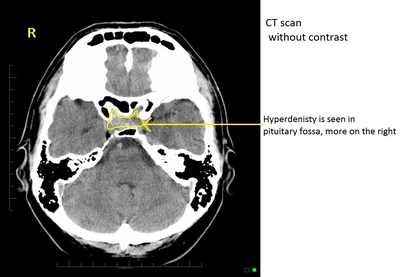Pituitary apoplexy CT
|
Pituitary apoplexy Microchapters |
|
Diagnosis |
|---|
|
Treatment |
|
Case Studies |
|
Pituitary apoplexy CT On the Web |
|
American Roentgen Ray Society Images of Pituitary apoplexy CT |
Editor-In-Chief: C. Michael Gibson, M.S., M.D. [1]; Associate Editor(s)-in-Chief: Akshun Kalia M.B.B.S.[2]
Overview
CT scan without contrast is the initial test of choice in emergency department patients who present with sudden-onset severe headache, visual loss, or ophthalmoplegia suggestive of pituitary apoplexy. CT scan can also help to differentiate whether subarachnoid hemorrhage is arising from pituitary hemorrhage or an aneurysm.
CT
CT scan without contrast is the initial test of choice in patients with pituitary apoplexy who present with sudden-onset severe headache, visual loss, or ophthalmoplegia. Pituitary apoplexy on CT presents as a hyper-dense lesion. CT scan can also help to differentiate whether subarachnoid hemorrhage is arising from pituitary hemorrhage or an aneurysm.[1] CT scan may show:
- Intrasellar mass
- Pituitary hemorrhage

References
- ↑ Briet C, Salenave S, Chanson P (2015). "Pituitary apoplexy". Endocrinol. Metab. Clin. North Am. 44 (1): 199–209. doi:10.1016/j.ecl.2014.10.016. PMID 25732655.